Celebrating the collaborations that transform materials from soil to skin, we set out to visit each designer creating a full look for the Climate Beneficial Fashion Gala. Here we share excerpts from three conversations: read on for inspiration from their design practices and pathways to sustainability, and how each consumer, designer, and the fashion industry as a whole can take part in environmental restoration. Join us for the Climate Beneficial Fashion Gala on September 23rd to see creations by these designers and more.
Written by Erin Walkenshaw and photographed by Paige Green.

Molly de Vries (above left) warmly greets us from the doorway of the cozy brick-red shop and workspace in Mill Valley, California that is the home of Ambatalia; her business, creative outlet, and solution to the modern dilemma of single-use plastic packaging. De Vries started Ambatalia in 2004 as a fabric store that focused on sustainable textiles and in the ensuing years the business has mimicked her own progression, moving from the question of how to avoid waste to how to create solutions that are relevant and welcome people into a broader conversation of how to live well. Her infectious enthusiasm has us quickly caught up in the stories of the textiles she sources and the historical and cultural context of her products that ‘support a non-disposable life.’
On a sun drenched property in rural west Sonoma County we meet with Rachel Alyn (above, second from left) at her Running River Organics studio. It is a rare summer afternoon when she is not on the road with her line of organic clothing and she has dye pots of fennel and loquat bubbling outside. Alyn, now in her sixth year of exploring natural dyes, lovingly watches over her dye pots as she shares with us her vision to produce seasonally hued clothing that is a reflection of the dye plants that she forages from the surrounding landscape.
The smell of baked goods beckons us through the door to Laurie Berliner’s Fairfax, California home and studio. Just behind Laurie (above, right) is Madge, a friendly Corgi eagerly trying to greet us and the namesake of Berliner’s Madge & Me apparel business. As we visit over tea and blueberry clafoutis Berliner shares with us how her former career as a criminal defense lawyer compels her to participate in building environmentally friendly regional textile manufacturing as a means to create the meaningful work opportunities that are lacking in the communities she served.
Davora Lindner and Camilla Eckersley (above, second from right) formed Prairie Underground in a Seattle library meeting room in 2004 following a long friendship that started on a playground in Nebraska. They co-evolved through their experiences in the anti-nuclear proliferation protests of the late 80’s, their shared aesthetic towards clothing, prior careers in art and design, and their desire to marry their principles to their work. We connect with Lindner and Eckersley at the Prairie Underground workshop in the Seattle Georgetown neighborhood. While getting a tour of their workspace and boutique they share their passion for using limitations as drivers for creative inspiration and how they apply this attitude when designing garments that are in line with their principles of sustainability.
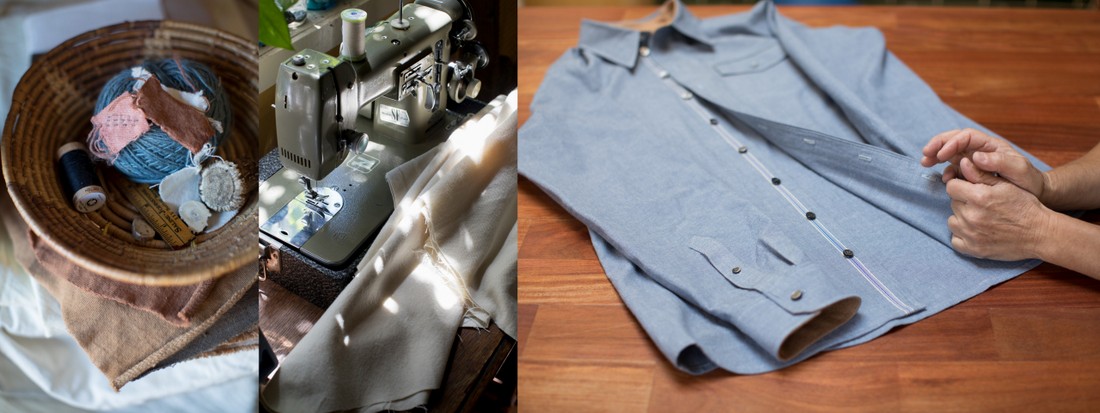
Scraps and collected items in the Ambatalia studio; at the sewing machine with Running River Organics; examining fine tailoring of Madge & Me garments.
Becoming a Material Goods Producer: Is there a moment that stands out as a step toward sustainability in your path as a designer?
Ambatalia: “I’m an obsessive thinker and for years I have been thinking about how to reduce garbage. I was inspired by the Japanese Furoshiki square cloth and textiles, because of their historical connection to carrying food, were a natural way for me to address this problem… I love sewing and everything, but really this is my solution to the massive problem of plastic waste and its impact on the environment.”
Running River Organics: “I went to a Primitive Skills gathering and saw the dyeing process in person for the first time and it sparked something in me, it felt so natural. I loved the wildcrafting aspect of it, foraging for plants, and extracting colors. From there I delved deeper into the natural dye process and learned about Fibershed.”
Madge & Me: “Here in Fairfax, I was out walking the dog, and I had a conversation with Rebecca Burgess… and sometimes you just have to follow these things. It made sense and was in line with many of the values that I grew up with in Marin around environmental conservation.”
Prairie Underground: (Lindner) “When we started our business our principles informed the type of product we wanted to make… We wanted to have a different model for our business than the accepted idea of “business is mercenary”. We don’t want to make more garbage in the world, cause people pain, or extort people for labor…sustainable textiles were an important part of that and have been since our first collection.”
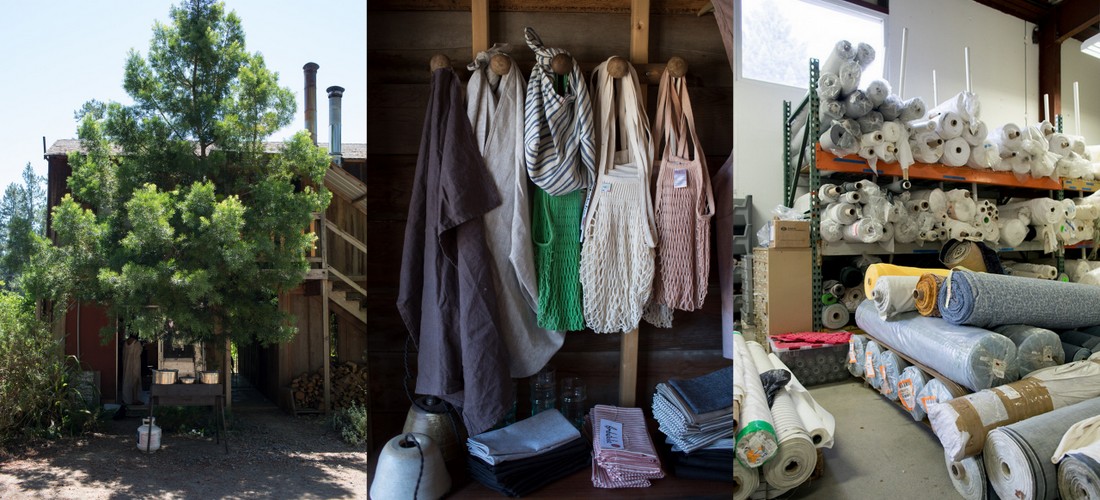
The rustic exterior of Running River Organics; mainstays of a non-disposable life with Ambatalia; sustainably sourced fabric awaiting Prairie Underground production.
Landscapes of Influence: Is there a landscape that you identify with, and one that informs your designs?
Ambatalia: “I go into the historical world of fashion. I watch a lot of documentaries. I love a work room — watching people work together — and fine couture… There are pieces from history that inspire me, and some little piece that I pick up from something I saw often comes through in my design.”
Running River Organics: “I grew up in a small community in northeastern Wisconsin and I wandered the woods a lot, interacting with nature. Now that I live here in Sonoma county with all these beautiful natural areas that surround us I still wander the woods a lot. Willow Creek, which is just down the road from here, is a spot where I do a lot of foraging…The plants and their colors, those colors that come out on dye swatch tests actually inform the design, rather than the other way around.”
Madge & Me: “This, (Berliner motions to the surrounding stately oak trees arching over the deck where we sit) my tree house. These oak trees that I live in and the dappled light that comes through… I grew up in San Anselmo with a grandmother who would sew with me, and took classes down the street from where I lived… I worked as a criminal defense lawyer in Vallejo until 2013 and it’s hard for me to take off the criminal lawyer hat. I see most things through a social justice lens.”
Prairie Underground: (Lindner) “Grassroots, progressive political organizing. The protests of the late ‘80s against nuclear proliferation. We grew up as activists in Nebraska… Art and music. Fashion was always a strong part of our friendship. We would talk about the garment in a holistic sense. We both had a passion for clothing as objects, and how they endure through time…Our best strongest designs have come out of Camilla and I’s debates with each other.” (Eckersley) “Every collection is very personal for me. They start out with the question- what do I want? We make clothing that we would actually want to wear and that work for our lives”
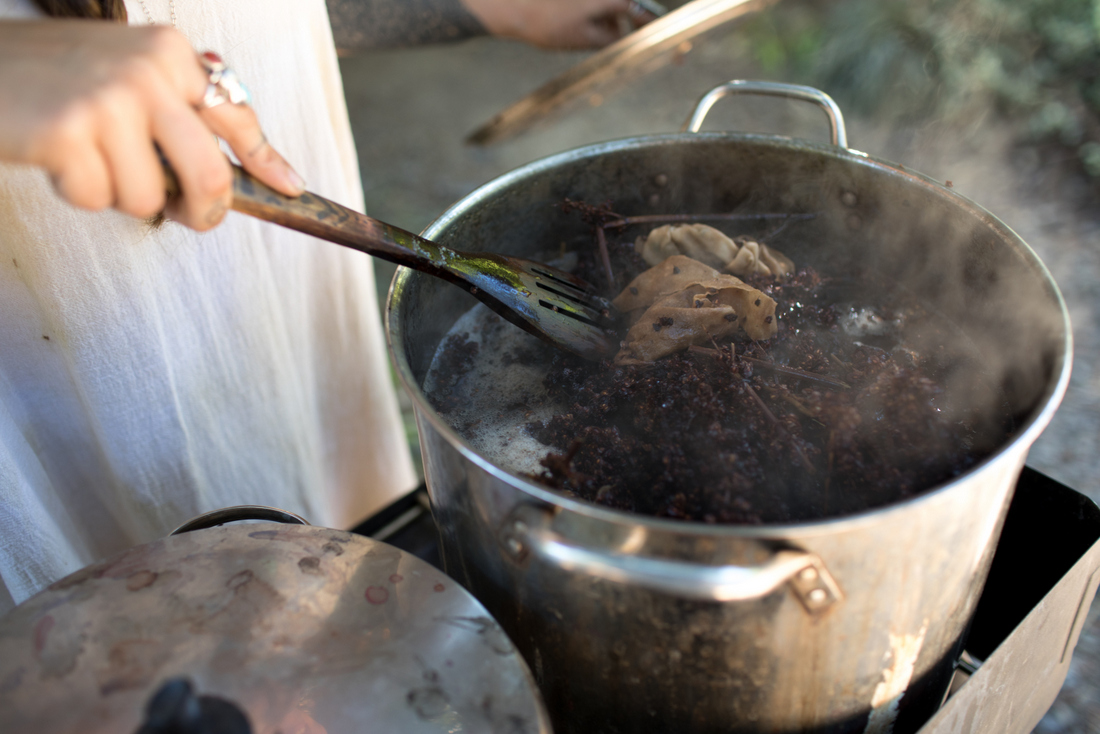
At the dye pot with Rachel Alyn of Running River Organics.
Design and Fashion as Participants in Environmental Restoration: What role do you think design and fashion can play in ecosystem restoration and strengthening the climate justice movement?
Ambatalia: “Personally, I learn through visual stimulation, and I find it hard to be interested in things that lack beauty. So for me fashion is a great avenue for communicating this message… I want to bring people into this world through enjoyment, through an experience that is relevant to them. I always hope that people will be inspired by my stuff and they will come to their own desire to go deeper through that inspiration because I don’t want to lecture anybody.”
Running River Organics: “I think zero-waste design and the re-emergence of nature-based textiles and dyes are bringing awareness to the fashion industry, and strength and opportunity for participation to the climate movement. When people seek out these sustainable alternatives, they are often supporting the local makers that have less of an impact on the environment.”
Madge & Me: “I am interested in the human ecosystem. With all of this marvelous mechanization we’ve lost the human element in all of it. Now we need meaningful work that does not hurt the environment. We need to focus on creating regional economies that provide right livelihood to the people living in those areas. This seems to me an industry that we can bring back — we are probably not bringing back steel, but this seems like an industry that we could do and we could do it right… We have to take a broader sense of the world of work for our children, Silicon Valley is not for everyone. We have to create schooling that teaches people how to sew.”
Prairie Underground: (Lindner) “This industry has so much potential for impact. Through our own experience we know we are encouraging a different consumption pattern. We get direct feedback from our customers. We know how long our clothing lasts. We design the textile to have longevity and the way that our clothing is made- it is intentionally made to be cared for and repaired and we have several tutorials and templates to send to customers when they have questions about how to repair our garments or repurpose them… We talk a lot about how we could also exist as a company that refashions things for people. It’s difficult due to logistics, but it is still something that we are fascinated with.”
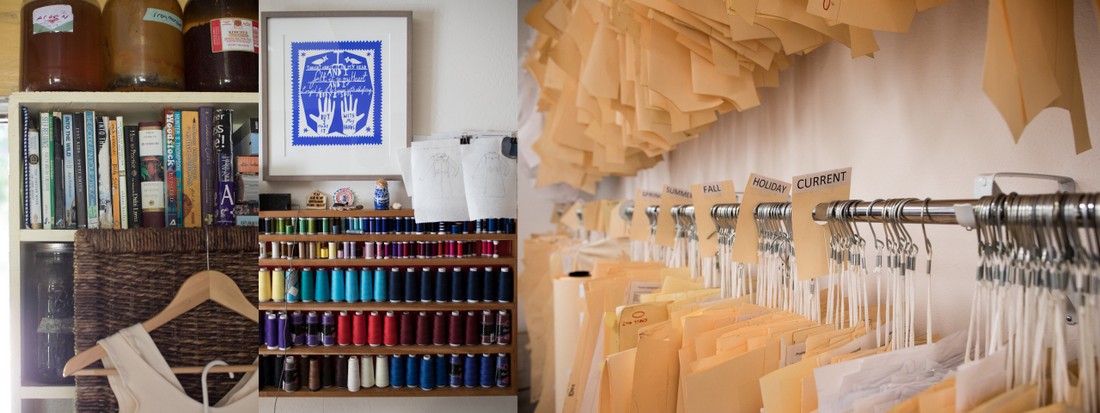
In the studio with Running River Organics (left), Madge & Me (center), and Prairie Underground (right).
On Mentors & Motivators:
Ambatalia: “Design is an opportunity for me to bring order into the world. There is an interplay between creating order and surrendering to the process of bringing a vision into reality. I have to walk away and let it brew, and then it comes into being… So many people inspire me. Ida Grae was one of the original plant dyers I knew around here and Sally Fox, God I love her Buffalo cotton.”
Running River Organics: “I am in love with this idea of having seasonal colors and I am inspired by the opportunity to showcase these natural fabrics and dyes. As the seasons change and those dye plants are abundant, that’s what will be in the collection… Interactions with my customers keep me motivated, doing events and seeing people reacting to the pieces, seeing how grateful people are…. It’s a huge part of it for me. Because they’re one of a kind and I make everything from scratch, it is just so important for me to have those opportunities to pass it on to the next person. It’s like an oil painting.”
Madge & Me: “The coursework I have done at the Apparel Arts Institute in Oakland has had a huge impact on me, especially Suzy Furrer and Heather Habig, both teachers at the school and turning out a bunch of folks in the bay area that are righteous pattern makers… Curtis Inglis is a local bike maker who I admire. He tries to produce a bike a week and I dig that business model of having just enough equipment to make it fly.”
Prairie Underground:(Eckersley) “I think what Eileen Fisher is doing with their used clothing business model is really interesting and exciting… I love that they are doing that, and how they are authentically bringing in the stories around sustainability… When we first started, Project Alabama [now evolved into Alabama Chanin] was inspiring for both of us. The way they looked for the skills that were regionally available and let that shape what they made.”
(Lindner) “When we get to meet our end users, it is incredibly inspiring for me to see how they put our pieces on. How they combine things and react to garments on each other. The way they put things together is so unique.”
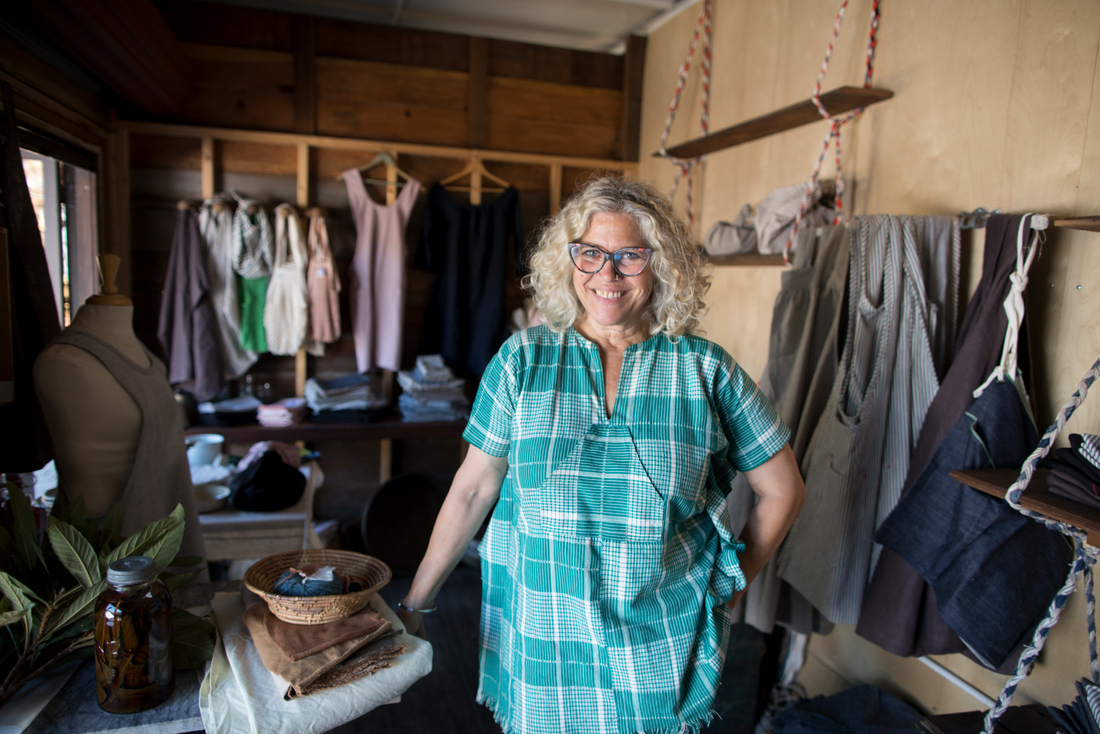
Try this on for size: What first steps can consumers take toward sustainable fashion?
Ambatalia: “Our everyday choices offer us an opportunity to make a difference. The only person I can change is myself… Think about what you truly will enjoy when you make a purchase. For me personally, I’d rather focus on that quality item, made with quality ingredients.”
Running River Organics: “My friends and I wanted organic underwear, and we couldn’t afford it, so I started making it. Find a way to produce something in your community.”
Madge & Me: “We have to create the world around us that supports local industry. We need to ask ourselves, ‘why are we importing all this stuff’ and find ways to participate in the solution… As far as starting in your own personal closet, I think a well-made tailored jacket is a great piece to build a wardrobe on.”
Prairie Underground: (Lindner) “Asking ourselves questions such as ‘How many pieces do we need in a wardrobe? How long are those pieces going to last?’… I do feel that this shift has started. I was shocked when we started selling used clothing on our website. We sold out of it. It was a test to see how people would respond, and how well we could tell that greater story behind a used piece of clothing.”
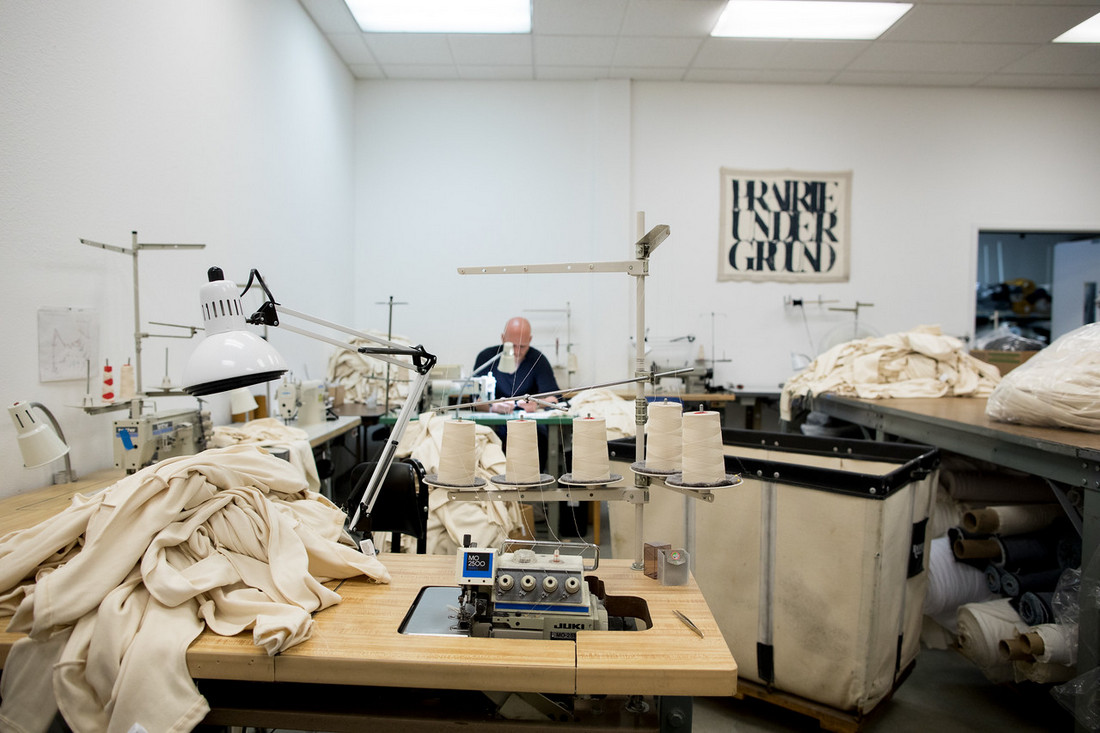
Try this on for size: What first steps can designers take toward sustainable fashion?
Ambatalia: “I can only speak for myself, but I came to a point where I realized that — God, I want to do something that I’m super engaged in and passionate about! So once you realize that, you just have to do it… I think people are starting to understand the true cost of things, so I guess I have to find a way to tell that story in a way that welcomes people to participate.”
Running River Organics: “Research. I did the work and kept seeking until I was happy with the source. It’s out there, sometimes you just have to look hard. Start implementing these ideas little by little, maybe create a line that is influenced by the Fibershed principles… I believe there is a Slow Fashion movement happening. I want to be a part of it, and if I can help make wearing organic, locally sourced clothing more possible then that’s great.”
Madge & Me: “Creating a viable local industry around textile manufacturing offers many opportunities for designers. Challenge yourself to ask questions around how the textiles you are using were produced and what kind of meaningful work that offered to people in that community… It’s one of the dirtiest industries, so there is an incredible amount of potential for positive change”.
Prairie Underground: (Lindner) “Camilla and I are both designers that respond very favorably and vigorously to limitations. We love that challenge, for us that becomes exciting and that attitude has helped us as we wed our principles to our designs…I think designers should stand in vigorous opposition to the idea of garments being like a tissue — disposable, un-washable, and they will just fall apart in some short amount of time.
(Eckersley) I feel that our diversity of products, and our team that readily adapts to the many variables that come up, such as shrinkage and uneven dye lots, allows us to work with more small, sustainable textile manufacturers…
(Lindner) There are a lot of opportunities for something to go wrong in apparel manufacturing. We collaborate with other designers, makers, and dyers to find ways to repurpose items that did not come out as we expected.”
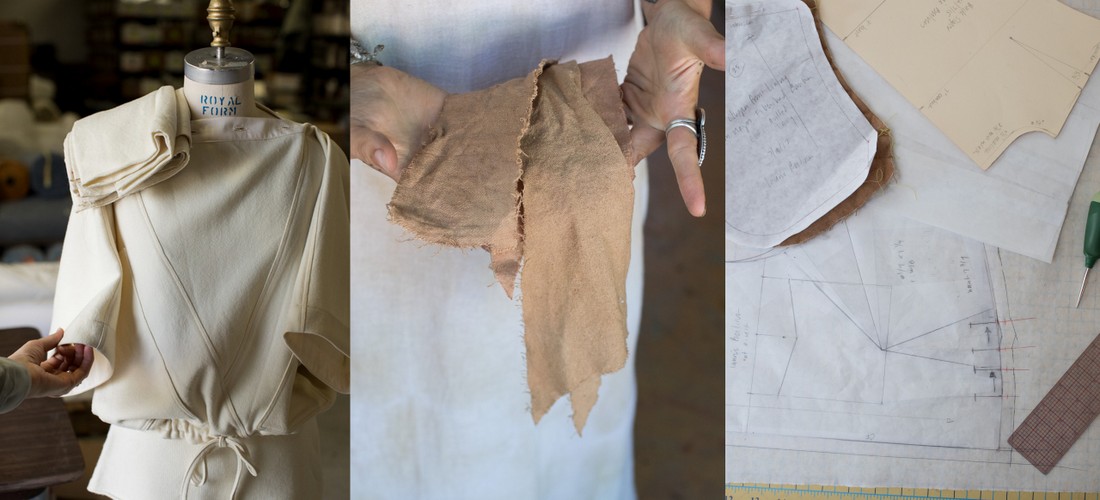
Processes of Climate Beneficial Fashion: sample garment by Prairie Underground; dye tests with Rachel Alyn; pattern making with Laurie Berliner.
Gut Reactions: What was your initial response to the Climate Beneficial Wool Community Supported Cloth?
Ambatalia: “I love this whole carbon thing. It’s genius…. it’s empowering and offers a vision of participatory action.”
Running River Organics: “It’s so good to hold… I feel incredibly honored to work with this textile, and to be a part of telling this story.”
Madge & Me: “We are at this critical point in this Fibershed movement, and the cloth is representative of that. We have to find a way to scale the movement up and I find this really intriguing.”
Prairie Underground: (Eckersley) “It feels like — ‘What! You can do that?!’ It’s exciting… I love clothes. I love fashion. Doing that in a way that feels ethical and exciting and inspiring is the best.”
(Lindner) “We view this piece [for the fashion show] as a proposition that you will always have. We both would wear this [garment] so if we don’t sell them, we get to keep them.”
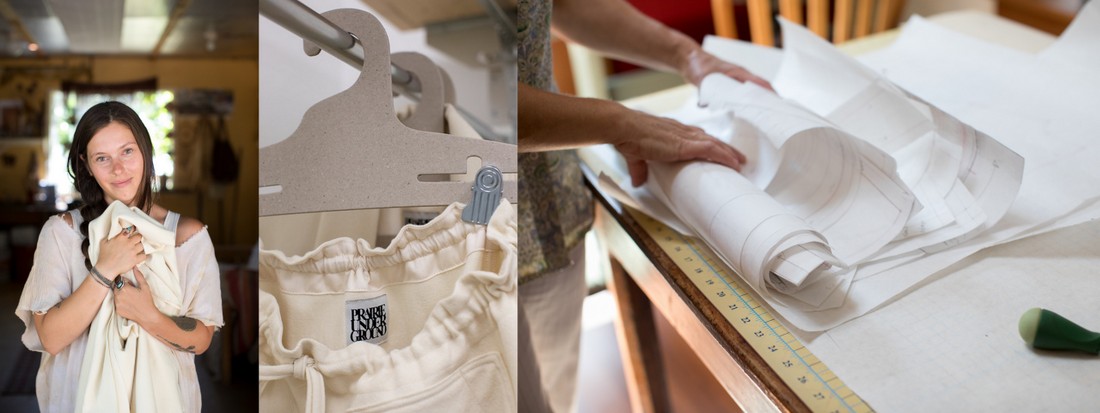
On September 23rd, Climate Beneficial Fashion created by Ambatalia, Running River Organics, Madge & Me, and Prairie Underground, will be presented on the runway at Big Mesa Farm. Reserve a ticket or table to connect with the Fibershed community as we explore value chains that ameliorate the causes of climate change, by investing in carbon farming and regional manufacturing. The evening includes farm-to-table fare, locally crafted beverages, live demonstrations to learn about natural dyeing and fiber processing, and a Marketplace to directly support regional goods and producers.
